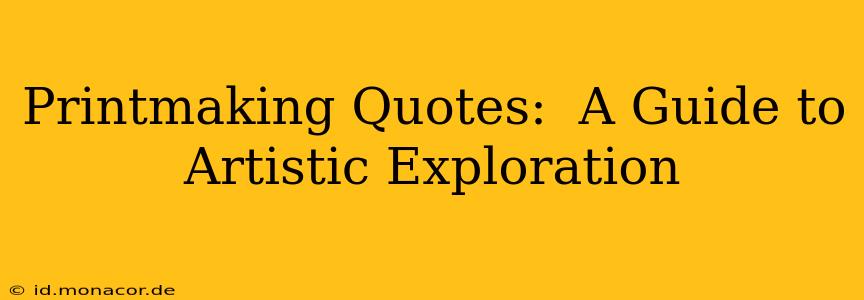Printmaking, a vibrant and versatile art form, allows artists to multiply their original creations, democratizing art and fostering artistic exploration. From the precise lines of engraving to the expressive textures of lithography, printmaking offers a unique creative journey. This guide delves into the world of printmaking, exploring its techniques and showcasing inspiring quotes that capture the essence of this powerful medium. We’ll also tackle some frequently asked questions about printmaking to further illuminate this rich artistic tradition.
What is Printmaking?
Printmaking encompasses a range of techniques where an artist creates a design on a matrix (like a block of wood, a metal plate, or a stone) and then transfers that image onto paper or other materials. This process allows for the creation of multiple impressions or prints, each possessing its own unique character. The inherent variability in each print, despite being from the same matrix, adds to the allure and value of printmaking.
Famous Printmaking Quotes
Many renowned artists have eloquently expressed their thoughts on the process and significance of printmaking. Here are some insightful quotes that capture the spirit of this art form:
-
"The print is not a reproduction; it is a unique expression of the artist's vision, realized through a different medium." - Unknown This quote encapsulates the unique nature of printmaking, where each print, while derived from the same matrix, possesses its individuality.
-
"Printmaking is the marriage of art and craft, where precision meets creativity." - Unknown This quote emphasizes the balance between the technical skill required and the imaginative expression within printmaking.
-
"The beauty of printmaking lies in its ability to translate the artist's vision into multiple realities." - Unknown This observation points to the power of printmaking in making art accessible to a wider audience.
Different Types of Printmaking
Several printmaking techniques exist, each offering its unique aesthetic possibilities:
-
Relief Printing (Woodcut, Wood Engraving, Linocut): In relief printing, the image is carved into a surface, leaving the areas to be printed raised. Ink is applied to these raised areas, and pressure transfers the image to the paper.
-
Intaglio Printing (Engraving, Etching, Drypoint): Intaglio techniques involve incising lines into a metal plate. Ink is forced into these grooves, and then wiped off the surface. When paper is pressed onto the plate, the ink from the grooves transfers, creating the image.
-
Planographic Printing (Lithography): Lithography uses a flat surface, typically a stone or metal plate, to create the image. The artist draws on the plate with a greasy substance, which repels water. Ink adheres only to the greasy areas, transferring the image to the paper.
-
Screen Printing (Serigraphy): Screen printing uses a stencil on a screen to apply ink to the paper. This technique allows for bold, vibrant colors and is often used for large-scale prints.
What are the benefits of printmaking?
Printmaking offers a unique blend of creative freedom and technical skill. Here are some of its key advantages:
-
Multiplicity: The ability to produce multiple copies of an original artwork is a defining characteristic.
-
Experimentation: Printmaking provides a platform for experimentation with different techniques and materials, leading to innovative and unexpected results.
-
Accessibility: The relatively lower cost of materials compared to painting or sculpture can make printmaking more accessible to aspiring artists.
-
Technical Mastery: Printmaking demands precise and skillful execution, fostering the development of technical proficiency.
What materials are needed for printmaking?
The specific materials vary greatly depending on the chosen technique. Generally, printmaking requires:
- Matrix: Wood blocks, metal plates, lithographic stones, or screens depending on the technique.
- Ink: Specialized inks are crucial for each printmaking method.
- Paper: Different papers are suited to various techniques.
- Tools: A wide array of tools are involved – from carving tools for relief printing to etching needles for intaglio.
Is printmaking difficult to learn?
Learning printmaking takes time, patience, and practice. While it can be challenging to master the technical aspects, the reward of creating unique and beautiful prints is well worth the effort. Many workshops and courses are available for beginners.
How can I sell my prints?
Selling prints can be achieved through various avenues, including online marketplaces like Etsy, art fairs, and galleries. Building a strong online presence and portfolio is crucial for success.
This guide provides a foundational understanding of the captivating world of printmaking. By exploring different techniques and appreciating the perspectives of artists past and present, we can gain a deeper appreciation for this enduring art form. The enduring legacy of printmaking, captured in these quotes and the countless prints created throughout history, continues to inspire artistic exploration and innovation.

